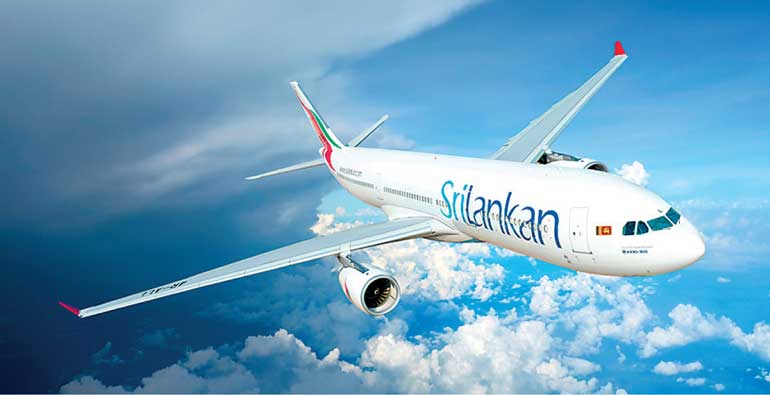Saturday Dec 13, 2025
Saturday Dec 13, 2025
Friday, 19 February 2016 00:00 - - {{hitsCtrl.values.hits}}
 In the interest of transparency, the Government should table in Parliament the precise financial implications of the re-fleeting of SriLankan Airlines
In the interest of transparency, the Government should table in Parliament the precise financial implications of the re-fleeting of SriLankan Airlines
We cannot solve our problems with the same level of thinking that created them
– Albert Einstein
If the Government is serious about rescinding the uneconomical and extravagant re-fleeting program of SriLankan Airlines, the solution is staring it in the face. 
The response in Parliament by the Prime Minister to a question by JVP MP Sunil Handunnetti on SriLankan Airlines is a sobering reminder that this Government is yet to decide its aviation policy and what it plans to do with the debt-ridden national carrier.
It is also a disturbing forewarning that the Government is yet to evolve its strategy for global connectivity in its grand design of the Western Province Megapolis.
On the purchase of the eight Airbus 350 aircraft, the Prime Minister has said the Government would have to decide whether to cancel the deal or go ahead with it and that 1.4 million dollars would have to be paid monthly if the Government went ahead with the deal.
In the interest of transparency, the Government should table in Parliament the precise financial implications of the re-fleeting of SriLankan Airlines. The accurate details of this massive transaction remains shrouded in official obfuscation.
It now seems that the purchase of the five Airbus A330 aircraft and the two A321 neo aircraft is a done deal. The official rethinking if any is confined to the eight A 350-900 aircraft.
State Enterprises Development Minister Kabir Hashim is on record stating that the State-owned carrier is making losses on its long-haul routes.
He is also on record insisting that “though we have ordered (A350s), we do not need them”. Addressing Parliament in December last year he has said “we have to pay 50 million dollars to cancel the order” and has quite correctly observed that “A350 production slots have some demand and it is not clear whether any attempt has been made to trade them”.
When will the Government stop the rhetoric and make way for serious introspection and decide on a feasible strategy on Sri Lanka’s future trajectory in commercial aviation? If the Government is serious about an economic recovery, it has to get out of the airline business.
The new CEO of SriLankan Airlines Captain Suren Ratwatte has recently told the press that the airline was delaying the delivery of an order of eight A350-900 aircrafts from Airbus until its acute financial position is sorted out.
“In view of the financial situation, the delivery of the eight A350-900 aircrafts will take longer than planned,” he told the Business Times on December 2015.
The Prime Minister’s use of the Sinhala aphorism ‘Gedera giyoth ambu nasi, maga hitiyoth tho nasi’ while picturesque is a tacit admission that his Global Advisory Committee headed by Charitha Ratwatte has not kept him advised on the developments in the Middle East.
His Advisory Committee and SriLankan Airlines seem oblivious to the developments in commercial aviation as a result of Iran emerging from the isolation of international sanctions. The President of Iran lost no time telling the world “The legs of Iran’s economy are now free of the chains of sanctions, and it’s time to build and grow.”
Iran officials have signed two agreements with Airbus covering new aircraft orders. These accords were inked at the Élysée Palace, Paris, during Iranian President Hassan Rouhani’s official visit to France with French President François Hollande.
Iran Air agreement with Airbus covers the acquisition of the full range of new Airbus airliners (73 wide bodies and 45 single aisle). The agreement for 118 new aircraft includes 21 A320ceo family, 24 A320neo family, 27 A330ceo family, 18 A330neo (-900), 16 A350-1000 and 12 A380. [Source www.Airbus.com Press Centre]
According to both Bloomberg and Reuter’s reports the Iranian demand for Airbus aircraft will place huge pressures on air craft delivery.
The Iranian purchases of Airbus aircraft is therefore a fortuitous window of opportunity for Sri Lanka. The only irritant may be the inflight facilities requested by Sri Lankan on their new aircraft.
Despite its determination to play catch up, the two Iranian airlines are unlikely to get in to the inflight luxury game. Religious orthodoxy will be a fact of life in Iran for the foreseeable future. But they do need the aircraft in a hurry.
At the recent aviation summit held in Iran, attended by all major stakeholders in the aviation industry, the Iranians made clear that their focus was on leasing not buying air craft.
In sharp contrast to the ‘Pie in the sky’ approach to aircraft modernisation of Sri Lankan aviation professionals, the Iranian demand for new aircraft is based on sound commercial logic.
Los Angelis is also called Teherangelis! An Iranian diaspora of nearly 1.5 million in North America are aching, yearning to travel on Iran Air. Europe also has a huge Iranian diaspora.
The Prime Minster should talk to the Ambassador of Iran. We should offer them the eight A 350s we have ordered. It may then turn out to be possible to say ‘Gedera giyoyth ambuwa hina wei!’
The previous Government may have entered in to an extravagant and unrealistic commitment. That is no excuse for the present management of SriLankan Airlines to go on the same reckless path. Opportunity is usually disguised as an insoluble problem.
‘Don’t throw good money after bad’ is a basic rule that successive governments have ignored. The problem with this Government is understandable. The decision-making Brahmins at its core are those associated with failed policies of the past. They are mired in the ‘sunk cost’ fallacies. So they ignore the basic rule that precludes taking to account irrevocable ‘sunk’ costs when making investments for the future.
If we continue to throw good money after bad, we may reach a point when we have to scream ‘Mehema giyoth ratama nasi’.